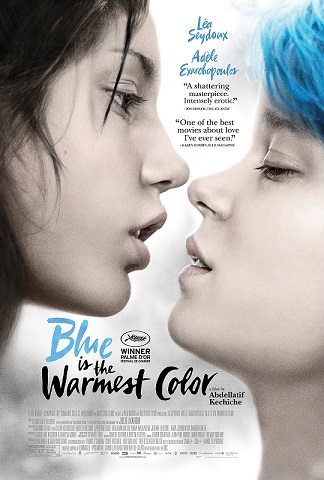Blue Is The Warmest Color
The 2013, Golden Palm (Palm D’Or) winner at the Cannes Film Festival, was an epic and erotic love story set in modern-day France. This film became the first film in the history of the festival, where the Golden Palm was given not only to the director but also to the two lead actresses Adèle Exarchopoulos and Léa Seydoux.
The film’s critical tide will be slowing down, but this film will force you to watch it again for its beauty, and use blue colour as the warmest of colours. Because of that, this film created many layers to it, to us to understand the true essence of the movie. The layers can be about lesbian relationships and can also be about first true love.
Adèle (Adèle Exarchopoulos) is the true heart and the center of the story where she meets Emma (Léa Seydoux), the backbone of the film. Adèle Exarchopoulos beautifully portrays the role of Adèle, who is in search of a partner whom she would enjoy spending time. But there also came the moment about making love. That’s where the very controversial 12-minute sex scene comes, where despite receiving the Golden Palm with the director, both the lead actress have come out and to share their feelings about the oppressive, intrusive, and even tyrannical demands director Abdellatif Kechiche made during the 10 days long shoot.
But one should also not forget the deep passion and vision of director Abdellatif Kechiche, where he places the camera, very close to Adèle, to give us a very personal and inside look of the life of Adèle, which rarely a film in any industry does it. The film very unique feature is the blue hair of Emma. The brilliance lies in writer and director Abdellatif Kechiche, is when Adèle first time meets Emma, the hair is blue because the love is still warm. But as times pass the blue colour also gets fades and eventually turns into black, eventually their love becomes cooler. This shows that the director using his cinematic brilliance has given us a treat in the form of a love story.
The director justifies in the story that this is just a love story. And there will be hate coming from the society. But the film shows, how in real life too, how love can overshadow the hate spread across society. Here the story ignores the phobia about lesbian love, but it is shown what true love looks like beyond any gender or place. The final moments of the film can be of shock for many, but it is for me one of the heartbreaking moments in cinema’s history.
The film boldly shows the coming out culture of a person as it is been difficult in every country, be it a first world country like France or a third world country like India, wherein both the countries the law is decriminalized, but the acceptance from the society is still difficult. Here in the case, when Adèle’s friends confronted her about being very close with Emma, visiting a lesbian bar, she got teased off by her friend of the same age saying that she is a lesbian. But the beauty about the story of Adèle is that she against all the odds continued to love Emma as the only true love of her life.
Blue is the Warmest colour is a very important film for our society and also a beautiful treat to moviegoers. I would rate it 5/5.
Disclaimer: The above review solely illustrates the views of the writer.




